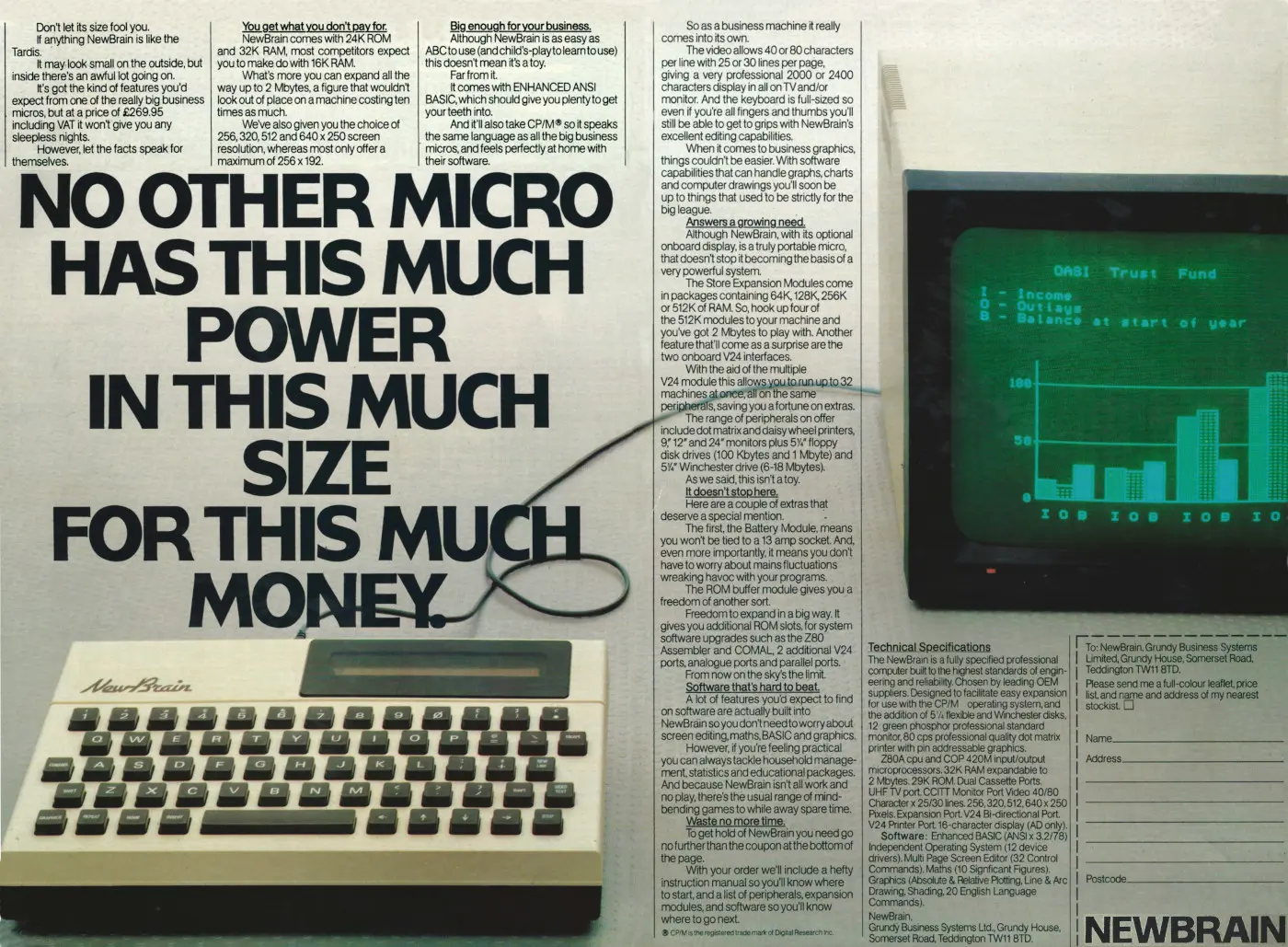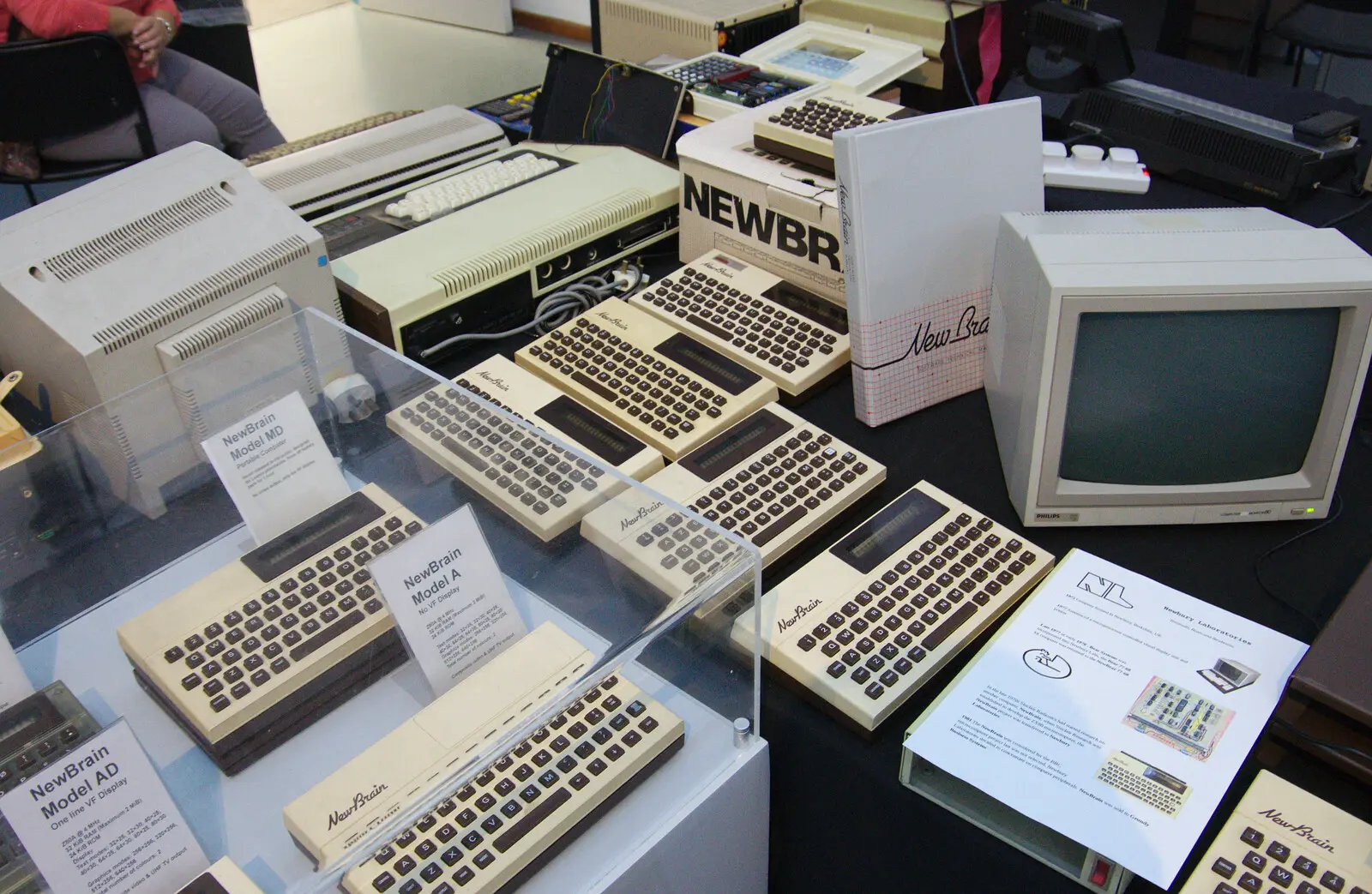Newbury/Grundy Advert - July 1982
From Personal Computer World

Newbrain: No other micro has this much power in this much size for this much money
This machine is possibly best known as the computer that might have been the BBC Micro, as chosen by the BBC for its influential Computer Literacy project, if its owners had only managed to actually produce a machine in the year it held the BBC contract.
However, these delays - probably caused by trying to meet the BBC specification - cost it the gig[1] and the BBC went the way of the Acorn Proton, which was launched at the end of 1981.
The Newbrain itself had been in gestation for several years, initially as a Sinclair Radionics project and then at Newbury Laboratories - a company which was also overseen by the same National Enterprise Board which had been sent in to manage troubled Sinclair Radionics - Clive Sinclair's electronics company in St. Ives.
It had been given to Newbury after the NEB had sold off Sinclair's calculator business - a move which was the final straw for Clive, who left shortly afterwards - and then sold off what remained of Sinclair Electronics, by now renamed Thandar, to a non-computer company which didn't want it[2].
The truth of when the NewBrain was canned as the actual "BBC micro" is hard to pin down.
The common story, as referenced already by Guy Kewney in Personal Computer World, was that NewBrain had been selected early for the BBC's project and then dropped at the last minute, but an article on The Register suggests that likely delays in upgrading it to suit the programme's requirements meant that it was ruled out early on.
According to a report by Nesta and the Science Museum in 2012, Newbury had been chosen because its part public ownership would have meant that the BBC would have avoided getting tangled up in any dubious commercial contracts, or risk being tied to a big commercial company.
However, because Newbury still hadn't produced anything by the end of 1980 - long before the TV programs were due to air - it was dropped, much to the BBC's despair, and the contract was opened out to Acorn, Tangerine, Research Machines, Sinclair, Transam and Nascom.
The list was carefully selected and was kept deliberately short in order to prevent being overwhelmed by bids, but was also chosen to filter out companies with "no reliable track record" as well as keep out possibly dominant Japanese and American companies[3].

A collection of Newbrains at the Centre for Computing History in Cambridge, 2019
Had the NewBrain appeared in 1980, when it was first announced, it would have been fairly revolutionary, particular in terms of hand-held computing.
It had 32K of memory which was expandable up to 2MB - a big number in 1982, and it included BASIC with a compiler, which was also fairly unusual.
By the summer of 1982, when Minister for IT Kenneth Baker was opening Grundy's R&D labs in Cambridge, the NewBrain's manufacturer - Thorn EMI Datatech - had ramped up to "high volume production" at its plant in Feltham[4].
The plant could churn out around 3,000 micros per week, but presumably didn't have to for too long as only 50,000 NewBrains were sold before Grundy shut down its Business Systems unit in 1983.
Grundy had become the owner of the NewBrain project having picked it up for a rumoured £600,000 in 1981[5] when previous owner Newbury Laboratories merged with its subsidiary Newbear and announced that it was going to produce a different micro instead[6].
It was also said that difficulties producing the NewBrain had contributed to Newbury's decision to bin the project and return to its core terminals business[7].
Meanwhile, Grundy Business Systems employees were given only 24 hours' notice whilst the fate of the company was being decided during the week of the 25th August. One member of staff, as reported in Personal Computer News of that week, said:
"[Liquidation] has been on the cards for a while. We've expected to be on 24 hours' notice since June".
It was said that expansion bought about by the imminent release of the CP/M Newbrains and a text-book mistake of increasing capital to manufacture quantities based upon Christmas sales figures from the previous year, all of which came on stream during summer as sales were falling, led to "massive debts"[8][9].
By September of 1983 it was all over. Liquidators from Deloitte, Haskins and Sells had been appointed during a creditors' meeting on September 8th and were hoping to start talking to potential buyers during the week of the 15th.
Despite winding up with debts of £3.5 million (about £17 million in 2025 terms), of which £940,000 was owed to the software house Thorn-EMI and another £178,000 was owed to Peachtree software, the creditors still had some faith in the company "if only a serious and sensible management team could aim it at the targets it was designed for"[10].
Time was of the essence though, as it was feared that public interest in the NewBrain would fade very quickly if it was left in limbo during a period of fierce competition in the micro market.
Lasky's, considered as probably the UK's largest outlet for the NewBrain hinted at what would happen if the machine was orphaned when Mike O'Reardon, Lasky's London-area Group Computer Manager stated "we will withdraw them and possibly sell them at a reduced price without back-up", but that "we will carry spare parts for those [already sold] units for the next five years"[11].
Some other dealers and software houses had been rumoured to be considering a rescue deal of their own, as there was a certain amount of loyalty towards the machine, plus the recent release of a disk system had put it in to "serious business machine" territory.
Software house Kuma had said that it would consider helping out in a rescue bid, whilst Alan Fish of Elstree Computer Centre was even more positive, saying
"we would certainly get together with other dealers to save the product, which is very highly rated by dealers. I see a big future for the machine because of its high technology... the disk system is superb... You can't have such a high technology machine just stopping"[12].
It's never a good time for a business to fail, but Grundy's collapse also meant that the machine lost its chance to become the official Norwegian schools' micro.
Despite that loss, the NewBrain was once again reprieved when Tradecom International of the Netherlands bought it from Grundy's liquidators.
It was thought that Tradecom's own survival rested to some extent on being able to fulfil orders it had taken for the machine[13].
The rescue was well timed as it seemed that users and third-party manufacturers were finally getting the hang of the NewBrain and were releasing more and more products for it every month.
Owners seemed especially loyal and user groups were active, including one in Cambridge run by ex-Grundy engineer Gerald McMullon.
In the first edition of the user group's newletter, McMullon identified the "beginning of the end" for Grundy as happening in November 1982, when Grundy's marketing department had been promising expansion units that R&D couldn't actually come up with[14].
The model with a built-in single-line display - the NewBrain AD - retailed for £267.50, about £1,280 in 2025 money.
Had it not lost the BBC contract, the NewBrain would have at least bettered Acorn on the pricing front. The cost of the "BBC Micro" was meant to have been £200 or less, but Acorn's machine started higher and quickly rose to £400, where it stayed for years.
It also reviewed reasonably well, with Dick Pountain writing in July 1982's Personal Computer World:
"The NewBrain is a well-made computer with some powerful and flexible software and hardware features designed into it. It has all the facilities to allow good bulletproof software to be written for it, and if this is supplied in ROM it will offer good value as a serious small business computer for even inexperienced users. In its naked form it is somewhat unfriendly to use, due to the very formal design approach and the poor documentation. Professional programmers and serious hobbyists will soon come to terms with this however, and will then find that it offers a lot of serious computer features at a toy computer price".
However, there was a nod to the extremely long gestation that the NewBrain had gone through, with Pountain writing
"When the NewBrain was announced to the world two years ago the design concept was significantly in advance of anything that had been seen in the field of hand-held computing ... it is also difficult not to reflect on what this design could achieve if it had been built with CMOS technology. The power requirements of the NMOS used are such that true battery operation with a sensible battery life is going to be very difficult to achieve"[15].
CMOS referred to the improved Complementary Metal Oxide Semiconductor chip technology. It had an advantage that it required significantly less power to run than the older NMOS technology, and it's almost essential for true portable applications.
At the time of the advert, Grundy was still intending to continue on development of a fully portable model by the end of 1982. This doesn't appear to have seen the light of day.
Date created: 01 December 2012
Last updated: 11 December 2024
Hint: use left and right cursor keys to navigate between adverts.
Sources
Text and otherwise-uncredited photos © nosher.net 2025. Dollar/GBP conversions, where used, assume $1.50 to £1. "Now" prices are calculated dynamically using average RPI per year.